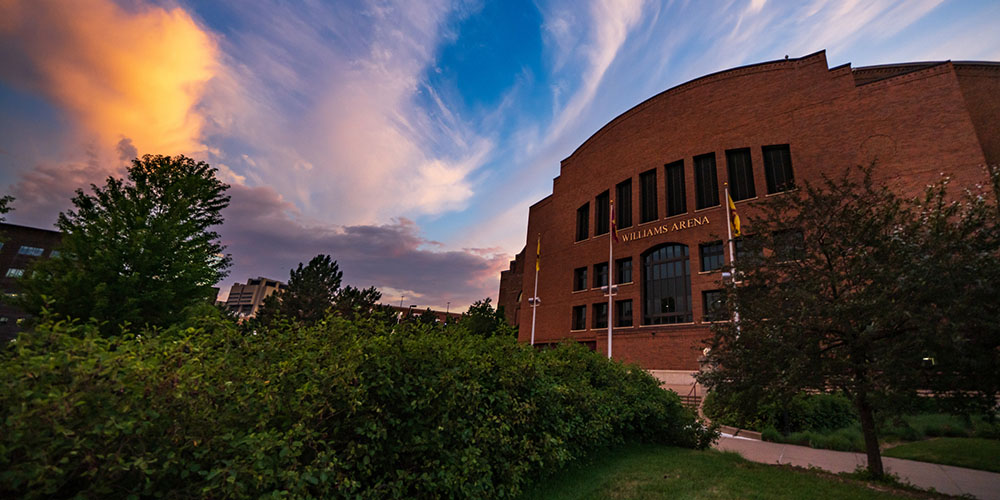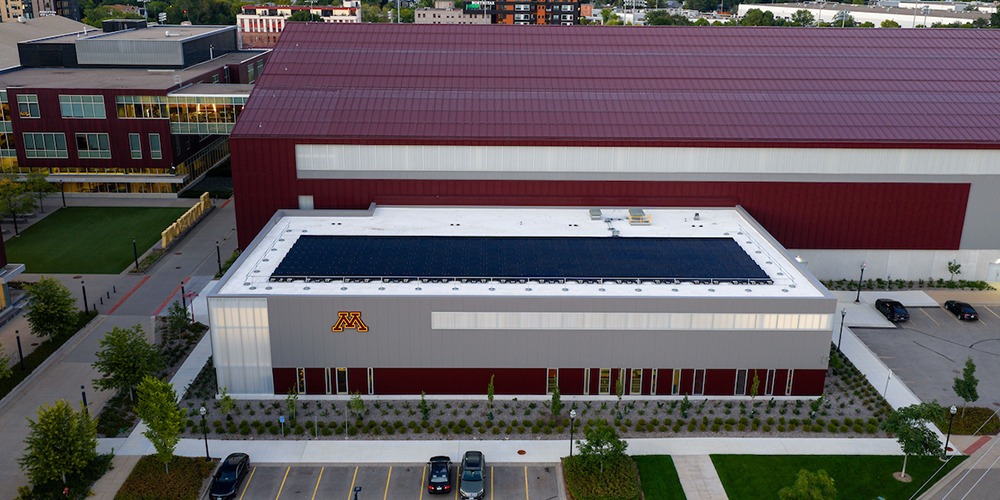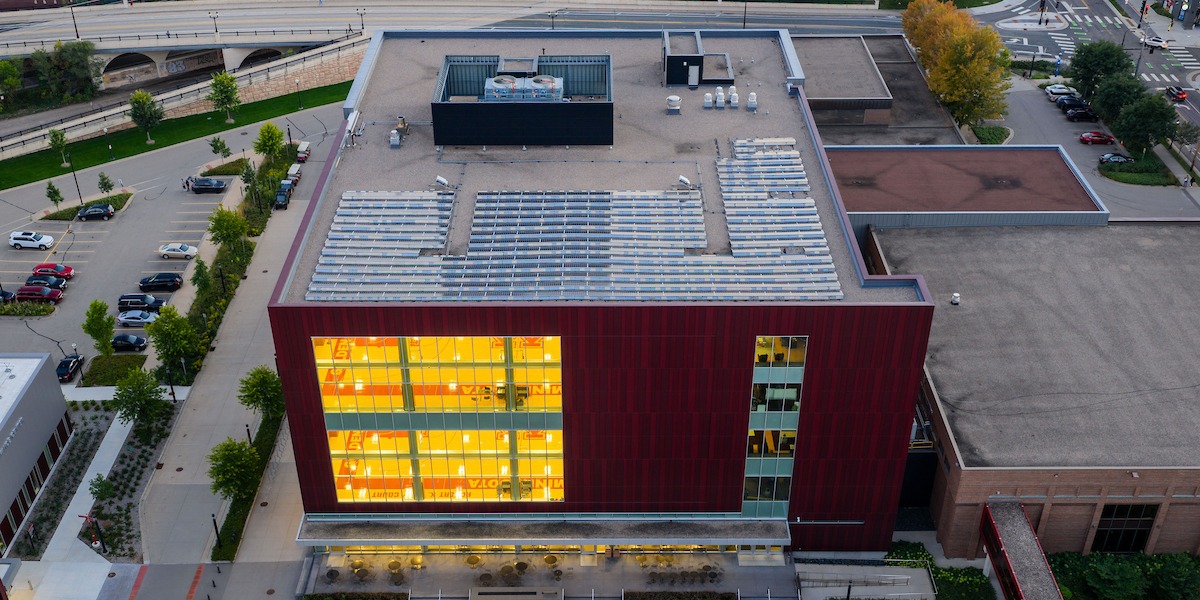University of Minnesota Athletics
Sustainability
Gopher Athletics is committed to being a program of excellence within all aspects of our sustainability platform as we compete to win both on and off the playing surface. We embrace the challenge and responsibility to innovate, evolve and set achievable goals while fostering a collaborative environment aligned with campus-wide sustainability strategies. Our collective effort strives to incorporate campus-wide climate action initiatives, values and goals while inspiring the greater community to make an impact on the environment through leadership and education of student-athletes, fans, staff and other key stakeholders.


Facility Details
Huntington Bank Stadium
Huntington Bank Stadium was built in 2009 on a former industrial railyard site, becoming the first football stadium in the nation to be LEED certified (LEED Silver). Concrete from existing grain elevators was recycled for use as the aggregate base for surrounding parking lots and 90% of the steel used in the stadium construction was Minneapolis-fabricated, recycled steel. From nation-leading waste diversion to stormwater management, Huntington Bank Stadium showcases its sustainability commitment week in and week out.
Energy: Huntington Bank Stadium has significantly reduced its energy consumption by implementing smart technologies like occupancy sensors, automated HVAC and lighting systems, and converting to LED lights. These upgrades, which meet ASHRAE 90.1 energy efficiency standards, have led to a 24% decrease in electricity use and a 31% reduction in steam use since 2010.
Stormwater: A bunch of stormwater features work together to manage all runoff from the surrounding 40 acres, treating and slowing water down before it gets to the Mississippi. The system will manage all runoff from a 3.5-inch rain event and filter and hold more than 140,000 gallons of water, mimicking conditions in the area before human habitation.
Water Conservation: By installing low-flow fixtures and sensor-controlled water systems as well as cutting potable water for irrigation by 50%, Huntington Bank Stadium has reduced its overall yearly water consumption by 57% since 2010.
Waste Diversion: Collaborative efforts by a large team consistently drive recognition as a waste diversion leader on the national stage. The team of Gopher Athletics facility staff, UMN’s Waste Recovery Services, Aramark, Marsden, and Multi-Venue Productions led to a season average diversion of 83% in 2024, with 2025 tracking even closer to the goal of Zero Waste.
Cleaning:
Transportation: Numerous transportation options are available to attendees of any event at Huntington Bank Stadium.
Energy: Huntington Bank Stadium has significantly reduced its energy consumption by implementing smart technologies like occupancy sensors, automated HVAC and lighting systems, and converting to LED lights. These upgrades, which meet ASHRAE 90.1 energy efficiency standards, have led to a 24% decrease in electricity use and a 31% reduction in steam use since 2010.
- 24% reduction in electric consumption between FY10-24
- 31% reduction in steam use between FY10-24
- Occupancy sensors for lighting
- Building Automation System for Light and HVAC Schedules for event spaces
- Building meets energy efficiency requirements of the ASHRAE 90.1 standard
- Concourse lighting LED conversion August 2018
- ~6,000 4’ fluorescent tube lights changed to LED 2014
Stormwater: A bunch of stormwater features work together to manage all runoff from the surrounding 40 acres, treating and slowing water down before it gets to the Mississippi. The system will manage all runoff from a 3.5-inch rain event and filter and hold more than 140,000 gallons of water, mimicking conditions in the area before human habitation.
- Bioswales
- Pervious walkways
- Bowl filter system (Sand and grit chambers)
- EPIC System
Water Conservation: By installing low-flow fixtures and sensor-controlled water systems as well as cutting potable water for irrigation by 50%, Huntington Bank Stadium has reduced its overall yearly water consumption by 57% since 2010.
- 57% reduction in yearly water consumption between FY10-24
- Low flow fixtures
- Auto on/off controlled
- 50% reduction in the use of potable water for landscape irrigation
Waste Diversion: Collaborative efforts by a large team consistently drive recognition as a waste diversion leader on the national stage. The team of Gopher Athletics facility staff, UMN’s Waste Recovery Services, Aramark, Marsden, and Multi-Venue Productions led to a season average diversion of 83% in 2024, with 2025 tracking even closer to the goal of Zero Waste.
- 91.1% waste diversion for Gopher Football game (November 2025)
- 90.2% waste diversion for Farm Aid 40 Concert (September 2025)
- 83.4% season average for 2024 home football season
- 38,220 lbs of organics for the year ~19 tons
- 31,580 lbs of recycling for the year- ~15.8 tons
- 119,230 lbs of waste diverted from landfill ~ 59.6 tons
- 81.6% season average for 2023 home football season.
- Collaboration makes this happen! Gopher Athletics facility staff, UMN Waste Recovery Services, Aramark, Marsen, and Multi-Venue Productions.
Cleaning:
- Green Seal GS-37 Certified Cleaning products used around the stadium
- Orbio- ionized salt water cleaning
Transportation: Numerous transportation options are available to attendees of any event at Huntington Bank Stadium.
- Located adjacent to Green Line Light Rail
- Bicycle Parking
- Carpooling (Lyft/Uber Drop-off and pickup locations)
- Bus Parking
Williams Arena & Maturi Pavilion
Energy: Williams Arena and Maturi Pavilion have drastically cut energy use, slashing electricity consumption by 63% since fiscal year 2008. A cornerstone of this achievement was a comprehensive 2018 upgrade to high-efficiency, dimmable LED sports lighting. This project replaced numerous inefficient, high-wattage metal halide lamps with a smaller number of advanced LED fixtures in both venues, significantly reducing the energy required to light events, practices, and facilitate maintenance work.
- LED Sports Lighting in both venues 2018
3M Arena at Mariucci
Recent Construction:
Energy:
- Ice Plant Replacement uses modern and efficient refrigeration. The new refrigerant system R-717 (anhydrous ammonia) has an ODP (ozone depletion potential) and GWP (Global Warming Potential) of 0, meaning that its use does not contribute to global warming
Energy:
- LED Sports Lighting over ice sheet October 2023
Ridder Arena & Baseline Tennis Center
Recent Construction:
Energy:
- Ice Plant Replacement uses modern and efficient refrigeration. The new refrigerant system R-717 (anhydrous ammonia) has an ODP (ozone depletion potential) and GWP (Global Warming Potential) of 0, meaning that its use does not contribute to global warming
Energy:
- LED Sports Lighting over ice sheet - Dec 2018
Bierman Building & Center for Excellence
Energy:

- 72kW Solar Panel System
- 110,000-120,000 kWh/yr produced by on-site (rooftop) solar panels
- Equivalent to about 4% of the buildings energy consumption
- Equivalent to the emissions from 12 homes energy use for a year

Larson Football Performance Center
Stormwater:
- 100’x270’ retention container from parking lots/site/roof rain liters
University of Minnesota Track & Field Stadium
Stormwater:
- 82’x152’ retention container -12,400 sf / 77,063 CF storage
Gymnastics Performance Center
Energy: The Gymnastics Performance Center meets stringent design targets to use 80% less energy than a similar facility built in 2003 (B3) b3mn.org. In addition, a 95.4kW solar array is installed on the roof, estimated to produce 115,000 kWh of energy (equivalent to 11 homes annual energy use).
Stormwater: Collection of stormwater on site is part of the Athlete’s Village stormwater system, a filtration and water collection system of water reuse for the site’s cooling towers. When operating smoothly, stormwater reuse provides nearly 90% of the makeup water for the cooling towers annually. In addition, landscape buffers serve as a form of pretreatment before runoff enters the storm sewer.
Waste Minimization: During construction of the facility, 75% of non-hazardous construction and demolition waste was diverted from the landfill to be recycled and reused.
Construction & Design Materials: A number of site, exterior, and interior construction and design elements harmonize to limit the environmental impact of the building and its construction and promote the health and well-being of building users.
Stormwater: Collection of stormwater on site is part of the Athlete’s Village stormwater system, a filtration and water collection system of water reuse for the site’s cooling towers. When operating smoothly, stormwater reuse provides nearly 90% of the makeup water for the cooling towers annually. In addition, landscape buffers serve as a form of pretreatment before runoff enters the storm sewer.
Waste Minimization: During construction of the facility, 75% of non-hazardous construction and demolition waste was diverted from the landfill to be recycled and reused.
Construction & Design Materials: A number of site, exterior, and interior construction and design elements harmonize to limit the environmental impact of the building and its construction and promote the health and well-being of building users.
- 62% of the interior products and finishes are verified to comply with the highest environmental standards, such as Greenguard Gold for paint, countertops, acoustical ceiling panels, and wall finishes, and CRI Green Label Plus for carpet tile.
- 96% of the landscape is made up of native plants.
- Large translucent windows provide excellent daylight without excessive glare, retain heat in the winter, and provide a barrier to bird strikes.



